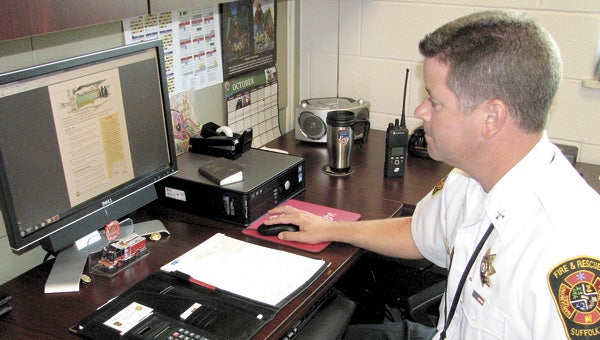Fire Prevention Week
Published 8:17 pm Thursday, October 7, 2010

Capt. James Dickens, Suffolk Fire Marshal, shows readers where they can access helpful tips and resources to create a fire escape plan for their home. Visit www.nfpa.org.
Be prepared, be safe
If you put off cleaning the living room before company comes over, you can stash the junk away last minute, and no one will know the difference.
However, if you put off properly equipping your home for the possibility of a fire, people — and your family — will know and feel the difference.
That is why the Suffolk Fire Marshal is urging residents to take the time during National Fire Prevention Week, Oct. 3-9, to properly equip your home, have an escape plan and know how to prevent common causes of residential fires.
“We are trying to move people away from complacency,” said James Dickens, Suffolk Fire Marshal captain. “How many times have you been in a building and a fire alarm has gone off and no one moves? Many times people don’t understand how important it is to prepare and take fire prevention seriously until they are involved in a fire or they see the firsthand effects of it. Fire prevention is so important. We cannot stress that enough.”
According to the U.S. Fire Administration, 86 percent of all fire-related deaths and 77 percent of all fire-related injuries are caused by home fires. There were nearly 400,000 residential fires with a resulting 2,500 deaths and 13,000 injuries in the United States in 2009.
To ensure your family does not become the victim of a household fire, the first step is to make sure your home is properly equipped with some basic fire prevention items, especially a fire extinguisher and smoke alarms.
Smoke detectors should be installed in every room and tested monthly. Their batteries should be changed every time you change your clocks to or from Daylight Savings Time.
Fire extinguishers should be in proper working order and stored where they are readily available for use and properly used by remembering the word “pass.”
“‘P’ stands for ‘Pull the pin.’ ‘A’ is for ‘Aim at the base of the fire — not at the top or the middle.’ And the ‘S’s are for ‘Squeeze the handle’ and ‘Sweep it back and forth’ when you discharge it,” Dickens said.
There should also be a family escape plan in your home. Each room should have two exits and because practice makes perfect, take a few minutes to go through the motions with your family and ensure everyone knows where they should meet outside.
All the preparation in the world is useless, however, if you’re not aware of the dangers in your own home.
While they might seem innocent enough, candles, cooking, cords and children are among the most prevalent causes of fires at home.
Candles should never be left unattended and should be kept at least 12 inches from anything flammable and in proper containers.
Cooking is the leading cause of home fires. Never leave it unattended. Should a fire occur in a pan on the stove, slowly slide a lid or cookie sheet over it.
Electrical cords should be replaced if frayed or showing other signs of aging. Outlets should not be overloaded. All modifications should be made by a professional. Never run an extension cord under carpet or use one permanently.
Finally, Dickens urges parents to always know what children are doing.
Whether by accident or unhealthy curiosity, children have the ability to cause fires. Matches and lighters should be child-safe and kept out of reach. Cover electrical outlets, keep candles out of reach, don’t hang towels on an oven rail and turn the handles of all pans inward, toward the wall.
For extensive tips on any of these subjects, visit www.nfpa.org.


